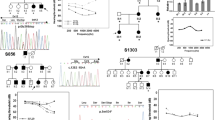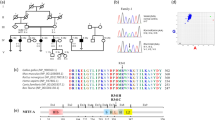Abstract
Pathogenic variants in the EPS8 gene result in nonsyndromic hearing loss. This gene encodes the EPS8 protein in cochlear inner hair cells and performs critical roles in stimulating actin polymerization and bundling. Thus far, only four pathogenic variations in EPS8 have been described. In this study, we report the fifth pathogenic variant in the EPS8 gene in an Iranian patient with DFNB102. Furthermore, we review literature cases with EPS8 mutations.
Similar content being viewed by others
One of the most prevalent sensory impairments, hearing loss (HL), affects approximately 1 in 500 infants. More than 50% of congenital HL cases are due to genetic factors1,2. Syndromic HL and nonsyndromic HL (NSHL) are two categories of hereditary HL3. Approximately 80% of all hereditary hearing problems are NSHL. These cases are genetically heterogeneous and can have autosomal, sex-linked, or mitochondrial inherited patterns2. Thus far, over 120 genes and 6,000 pathogenic mutations in nonsyndromic HL have been identified, and approximately 65% of these genetic factors follow an autosomal recessive (AR) inherited pattern (Hereditary Hearing Loss Homepage; https://hereditaryhearingloss.org accessed Feb 2021). Epidermal Growth Factor Receptor Pathway Substrate 8 (EPS8) (MIM#600206) is one of several genes in which mutations cause nonsyndromic hearing loss4,5.
EPS8 is located on 12p12.3 and consists of 21 exons. This gene encodes the EPS8 protein, which is composed of 822 amino acids5,6. The EPS8 protein comprises a pleckstrin homology (PH) and SRC homology 3 (SH3) domain7.
In the inner ear, specialized mechanoreceptor cells, called hair cells, utilize mechanoelectrical transduction to detect sound. The stereocilia of the auditory cell are arranged in rows of varying heights to produce precise monotone staircase patterns8. EPS8 and other proteins situated at the ends of the tallest stereocilia perform critical functions in stimulating actin polymerization and bundling9,10. Actin-based movement may be regulated by EPS8, an evolutionarily conserved actin dynamics regulator, by covering the barbed terminal of actin filaments and encouraging actin packing. Furthermore, EPS8 plays a key role in the maturation of inner hair cells, and it is essential for regulating the growth and operation of mammalian auditory hair cells10. Mutations in EPS8 have been identified as causes of deafness and autosomal recessive 102 (DFNB102) (MIM#615974)-related hearing impairment5,11. In 2011, Zampini et al. showed that EPS8 mutations caused profound NSHL in mice10. Later, Behlouli et al. (2014) identified the first human case with an EPS8 mutation, and this individual presented with nonsyndromic profound congenital hearing loss5.
Here, we describe an Iranian subject with DFNB102 caused by a pathogenic variant in EPS8 (NM_004447: c.1259 G > A, p. Trp420Ter). Finally, we review previous cases with EPS8 mutations.
This article reports an Iranian patient with hearing loss who was born to consanguineous parents (Fig. 1a). The proband (individual V-1) was a 30-year-old female. All the family members were examined properly. Likewise, the subjects’ blood samples were drawn for genetic analysis and supplementary examinations. The patient and parents signed written informed consent forms for the publication of the results. This paper was written according to the CARE Statement12.
The QIAamp DNA Blood Mini Kit was used to extract genomic DNA from peripheral white blood cells in preparation for sequencing. Following the manufacturer’s instructions, we captured genomic DNA using the SureSelect XT Human All Exon V6 reagent kit (cat. no. 5190-8863; Agilent Technologies, Inc.). Coding DNA samples that were collected were sequenced using an Illumina NovaSeq6000 with 100-bp paired-end sequencing. They were aligned to the human reference genome (hg19) using the Burrows‒Wheeler Aligner13. The Genome Analysis Toolkit (GATK) software was used to call single-nucleotide polymorphisms (SNPs). Variants were annotated by ANNOVAR14,15. Each variant was assigned to one of five groups based on the ACMG guidelines for the classification of sequence variations: pathogenic, likely pathogenic, variant of unknown significance, likely benign, and benign. The patients’ phenotype was compared to the phenotypic appearance related to the candidate genes. The OMIM database was used to extract the core phenotypic appearance of the mutation (OMIM #615974). Whole-exome sequencing (WES) identified a homozygous pathogenic variant (NM_004447: c.1259 G > A, p. Trp420Ter) in the EPS8 gene in Subject V-1.
Sanger sequencing verified the presence of this variant. The fragments covering the mutant region were amplified using polymerase chain reaction (PCR). The findings of the Sanger sequencing were analyzed using Chromas Lite v2.01. Oligo Primer Designer V.7 was used to design primers16.
The proband was a 30-year-old Iranian female with prelingual, profound, nonsyndromic HL. She was born to consanguineous parents and was delivered naturally by vaginal birth at 40 weeks gestation at a weight of 4,200 g. After birth, her growth and development were normal. Clinical evaluation failed to detect additional symptoms indicating syndromic hearing loss. There were no cochlear-vestibular abnormalities found on her temporal bone CT scan, and she did not have any balance problems. Both parents and the three other siblings did not have signs of hearing impairment.
A homozygous nonsense variant in EPS8 (NM_004447: c.1259 G > A, p. Trp420Ter) was discovered using whole-exome sequencing of a proband blood sample. An analysis of the segregation of this mutation based on Sanger sequencing confirmed the homozygous variant in the proband and showed that the variant was present in the heterozygous state in both parents (Fig. 1b).
NSHL is genetically heterogeneous, and thus far, numerous genes, such as EPS8, have been identified for this type of hearing loss5. For instance, the EPS8 gene mutations that cause autosomal recessive NSHL are known as DFNB1025,11.
Thus far, only four pathogenic variations in EPS8 have been reported in four families. These variants include one nonsense mutation resulting from the substitution of C to T in the coding region (NM_004447: c.88 C > T, p. Glu30Ter), two splicing variants (NM_004447: c.205-8 A > Gp.(?), c.1435-2 A > T, p. His479Cysfs*), and one missense variant resulting from the deletion of an A residue in the coding region (NM_004447: c.115delA, p. Thr39Glnfs*32)5,11,17,18. Three of these variations were in a homozygous state (NM_004447: c.88 C > T, c.205-8 A > G, and c.115delA). One had a splice variation that was apparently homozygous due to a 65.9 kb intragenic deletion that covered the variation region (NM_004447: c.1435-2 A > T)5,11,17,18. We also identified a fifth pathogenic variation, NM_004447: c.1259 G > A, p. Trp420Ter. This nonsense mutation is predicted to produce either a truncated protein at amino acid position 420 or no protein at all due to nonsense-mediated mRNA decay (NMD)19. This variant is classified as “likely pathogenic” based on the PVS1 and PM2 criteria of the ACMG/AMP guidelines. Regarding the clinical characteristics, our patient remarkably resembles the individuals reported previously. The reported affected individuals and our patient manifested profound nonsyndromic hearing loss that presented early in life or at birth (Table 1). They did not have any vestibular malformations or balance problems11.
To conclude, we report the fifth pathogenic mutation in EPS8 in an Iranian patient affected by profound congenital hearing loss. Her parents and three siblings did not have any hearing impairments. To date, only four patients with pathogenic EPS8 mutations have been reported. Thus, knowledge of the pathogenic variation of this gene is limited. Reporting the case more rigorously could contribute to diagnosis, genetic counseling leading to more effective supportive care, and even complete care of this disorder employing recently developed technologies.
HGV Database
The relevant data from this Data Report are hosted at the Human Genome Variation Database at https://doi.org/10.6084/m9.figshare.hgv.3264.
Data availability
All data generated or analyzed during this study are included in the final published article.
References
Kremer, H. Hereditary hearing loss; about the known and the unknown. Hear. Res. 376, 58–68 (2019).
Vele, O. & Schrijver, I. Inherited hearing loss: molecular genetics and diagnostic testing. Expert Opin. Med. Diagn. 2, 231–248 (2008).
Shearer, A. E., Hildebrand, M. S. & Smith, R. J. H. Hereditary hearing loss and deafness overview. GeneReviews®[Internet] (2017).
Meena, R. & Ayub, M. Genetics Of Human Hereditary Hearing Impairment. J. Ayub Med. Coll. Abbottabad JAMC 29, 671–676 (2017).
Behlouli, A. et al. EPS8, encoding an actin-binding protein of cochlear hair cell stereocilia, is a new causal gene for autosomal recessive profound deafness. Orphanet J. Rare Dis. 9, 1–6 (2014).
O’Leary, N. A. et al. Reference sequence (RefSeq) database at NCBI: current status, taxonomic expansion, and functional annotation. Nucleic Acids Res 44, D733–D745 (2016).
UniProt: the universal protein knowledgebase in 2021. Nucleic Acids Res. 49, D480–D489 (2021).
Pacentine, I., Chatterjee, P. & Barr-Gillespie, P. G. Stereocilia rootlets: actin-based structures that are essential for structural stability of the hair bundle. Int. J. Mol. Sci. 21, 324 (2020).
Belyantseva, I. A. et al. Myosin-XVa is required for tip localization of whirlin and differential elongation of hair-cell stereocilia. Nat. Cell Biol. 7, 148–156 (2005).
Zampini, V. et al. Eps8 regulates hair bundle length and functional maturation of mammalian auditory hair cells. PLoS Biol. 9, e1001048 (2011).
Yu, S. et al. Apparent homozygosity for a novel splicing variant in EPS8 causes congenital profound hearing loss. Eur. J. Med. Genet. 64, 104362 (2021).
Gagnier, J. J. et al. The CARE guidelines: consensus‐based clinical case reporting guideline development. at (2013).
Li, H. & Durbin, R. Fast and accurate long-read alignment with Burrows–Wheeler transform. Bioinformatics 26, 589–595 (2010).
Wang, K., Li, M. & Hakonarson, H. ANNOVAR: functional annotation of genetic variants from high-throughput sequencing data. Nucleic Acids Res. 38, e164–e164 (2010).
Ehsani, E. et al. Genotypic and phenotypic spectrum of Myofibrillar Myopathy 7 as a result of Kyphoscoliosis Peptidase deficiency: the first description of a missense mutation in KY and literature review. Eur. J. Med. Genet. 104552 (2022).
Rychlik, W. OLIGO 7 primer analysis software. PCR Prim. Des. 35–59 (2007).
Richard, E. M. et al. Global genetic insight contributed by consanguineous Pakistani families segregating hearing loss. Hum. Mutat. 40, 53–72 (2019).
Yan, D. et al. Spectrum of DNA variants for non-syndromic deafness in a large cohort from multiple continents. Hum. Genet. 135, 953–961 (2016).
Baker, K. E. & Parker, R. Nonsense-mediated mRNA decay: terminating erroneous gene expression. Curr. Opin. Cell Biol. 16, 293–299 (2004).
Acknowledgements
The authors would like to thank Comprehensive Medical Genetics Center, Shiraz, Fars province, Iran for their contribution to this study.
Funding
This study was financially supported by Shiraz University of Medical Sciences.
Author information
Authors and Affiliations
Contributions
Z.A.: conceptualization, methodology, writing the original draft and reviewing and editing the manuscript. S.A.D.: conceptualization and supervision. H.J.K.: methodology and project administration. S.M.B.T.: physical examination and clinical characterization. J.M.: review. M.D.: physical examination and clinical characterization.
Corresponding author
Ethics declarations
Competing interests
The authors declare no competing interests.
Ethical approval and consent of the participants
Written informed consent for participation in the study and publication was obtained from each patient or, in the case of minors, from their parents. The Ethics Committee of Shiraz University of Medical Sciences approved this study.
Additional information
Publisher’s note Springer Nature remains neutral with regard to jurisdictional claims in published maps and institutional affiliations.
Rights and permissions
Open Access This article is licensed under a Creative Commons Attribution 4.0 International License, which permits use, sharing, adaptation, distribution and reproduction in any medium or format, as long as you give appropriate credit to the original author(s) and the source, provide a link to the Creative Commons license, and indicate if changes were made. The images or other third party material in this article are included in the article’s Creative Commons license, unless indicated otherwise in a credit line to the material. If material is not included in the article’s Creative Commons license and your intended use is not permitted by statutory regulation or exceeds the permitted use, you will need to obtain permission directly from the copyright holder. To view a copy of this license, visit http://creativecommons.org/licenses/by/4.0/.
About this article
Cite this article
Abbasi, Z., Jafari Khamirani, H., Tabei, S.M.B. et al. EPS8 variant causes deafness, autosomal recessive 102 (DFNB102) and literature review. Hum Genome Var 10, 1 (2023). https://doi.org/10.1038/s41439-023-00229-w
Received:
Revised:
Accepted:
Published:
DOI: https://doi.org/10.1038/s41439-023-00229-w




